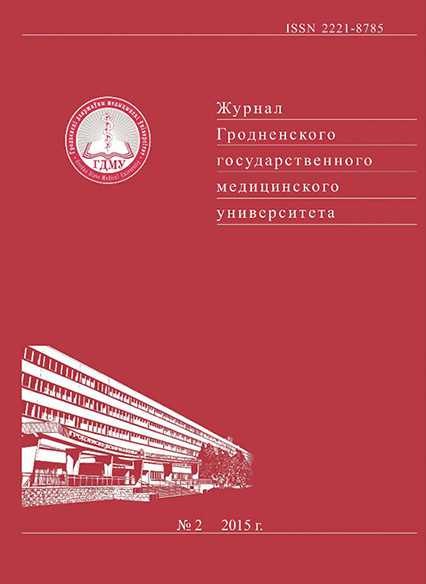МИКРОБИОМ КИШЕЧНИКА ЧЕЛОВЕКА И ЕГО ВЛИЯНИЕ НА МЕТАБОЛИЗМ
Аннотация
В обзоре отображено современное представление о микробиоте кишечника и ее влиянии на метаболизм макроорганизма. Приведены сведения о структуре кишечного барьера и функциях составляющих его клеточных элементов. Показана зависимость структуры микробного сообщества от нутриентов, поступающих в желудочно-кишечный тракт. Обсуждается влияние микробного дисбаланса на продукцию свободных жирных кислот в кишечнике, аминокислот и других биологически активных соединений, поступление которых в организм человека может оказывать влияние на течение патологических процессов. Обсуждается возможность нутриентов и метаболитов, нарабатываемых кишечной микрофлорой, модулировать проницаемость кишечного барьера, влиять на образование провоспалительных цитокинов, характерных для местного и системного иммунного ответа.Литература
Любецкая, А. В. Применение потоковой модели для изучения метаболизма Escherichia coli / А. В. Любецкая, Л. И. Рубанов, М. С. Гельфанд // Биохимия – 2006. – Т. 71. №11. – С. 1544 – 1549.
Олескин, А. В. Нейрохимия, симбиотическая микрофлора и питание (биополитический подход) // Гастроэнтерология Санкт-Петербурга. – 2009. – № 1. – С. 8–16.
Орешко, Л. С. Метаболические эффекты и их роль в функционировании желудочно-кишечного тракта у больных целиакией / Л. С. Орешко, М. С. Балагаева, Ю. С. Крылова, Н.В. Ратманова, Е. А. Соловьева // Гастроэнтерология Санкт-Петербурга. – 2012. – №1, С. 27 – 28.
Шендеров, Б. А. Функциональное питание и его роль в профилактике метаболического синдрома. М.: «ДеЛи принт», 2008. – 318 с.
Albenberg, L. G. Diet and the intestinal microbiome: associations, functions, and implications for health and disease / L. G. Albenberg, G. D. Wu // Gastroenterology. – 2014. – Vol.146, N6. – P. 1564 – 1572.
Artificial nutrition and intestinal mucosal barrier functionality / C. D. Anastasilakis et al. // Digestion. – 2013 – Vol. 88. – P. 193 – 208.
Bacterial translocation: overview of mechanisms and clinical impact / S. Balzan et al. //J Gastroenterol Hepatol. – 2007 – Vol. 22. – P. 464 – 471.
Bannai, M. Detection of dietary glutamate via gut–brain axis / M. Bannai, K.Torii // J. Anim. Sci. – 2013. – Vol. 91. – P. 1974-1981.
Cani, P. D. Interplay between obesity and associated metabolic disorders: new insights into the gut microbiota / P. D. Cani, N. M. Delzenne // Curr Opin Pharmacol. – 2009. – Vol. 9. – P. 737–743.
Cani, P. D. Involvement of the gut microbiota in the development of low grade inflammation associated with obesity: focus on this neglected partner / P. D. Cani, N. M. Delzenne // Acta Gastroenterol Belg. – 2010. – Vol. 73. – P. 267–269.
Modulation of gut microbiota by antibiotics improves insulin signalling in high-fat fed mice / B. M. Carvalho, D. Guadagnini, D. M. Tsukumo et al. // Diabetologia. – 2012. – Vol. 55. – P. 2823–2834.
Cantarel, B. L. Complex carbohydrate utilization by the healthy human microbiome / B. L. Cantarel, V. Lombard, B. Henrissat // PLoS One. – 2012. –Vol. 7. – P. 1–10.
Cheng, H. Origin, differentiation and renewal of the four main epithelial cell types in the mouse small intestine. III. Entero-endocrine cells / H. Cheng, C. P. Leblond. // Am J Anat. – 1974. – Vol. 141. – P. 503–519.
Bifidobacteria isolated from infants and cultured on human milk oligosaccharides affect intestinal epithelial function / M. Chichlowski, G. De Lartigue, J.B. German et al. // J Pediatr Gastroenterol Nutr. – 2012. – Vol. 55. – P. 321–327.
Circu, M. L. Intestinal redox biology and oxidative stress / M. L Circu, T. Y. Aw // Semin Cell Dev Biol. – 2012. – Vol. 23. – P. 729–737.
Systemic multicompartmental effects of the gut microbiome on mouse metabolic phenotypes / S. P. Claus, T. M. Tsang, Y. Wang et al. // Mol Syst Biol. – 2008. – Vol. 4. – P. 219 – 222.
Targeting gut microbiota in obesity: effects of prebiotics and probiotics / N. M. Delzenne, A. M. Neyrinck, F. Backhed et al. // Nat Rev Endocrinol. – 2011. – Vol. 7. – P. 639–646.
Devaraj, S. The human gut microbiome and body metabolism: implications for obesity and diabetes / S. Devaraj, P. Hemarajata, J. Versalovic // Clin Chem. – 2013. – Vol. 59. – P. 617–628.
Available versus digestible amino acids – new stable isotope methods / R. Elango, C. Levesque, R. O. Bal et al. // Brit.J.Nutr. – 2012. – Vol. 108. – Р. 306 – 314.
Predicting a human gut microbiota’s response to diet in gnotobiotic mice / J.J. Faith, N.P. McNulty, F.E. Rey et al. // Science. – 2011. – Vol. 333. – P. 101 – 104.
Fonseka, A. Gut sensing mechanisms / A. Fonseka, J. Kaunitz // Curr. Gastroenterol. Rep. – 2009. – Vol. 11. – P. 442 – 447.
Fuller, M. Determination of protein and amino acid digestibility in foods including implications of gut microbial amino acid synthesis // Brit.J.Nutr. – 2012. – Vol. 108. – Р. 238 – 246.
Fuller, M.F. Nitrogen cycling in the gut / M.F. Fuller, P.J. Reeds // Annu Rev Nutr. – 1998. – Vol. 18. – P. 385 – 411.
Butyrate improves insulin sensitivity and increases energy expenditure in mice / Z. Gao, J. Yin, J. Zhang et al. // Diabetes. – 2009. – Vol. 58. – P. 1509 – 1517.
Endo-beta-N-acetylglucosaminidases from infant-gut associated bifidobacteria release complex N-glycans from human milk glycoproteins / D. Garrido, C. Nwosu, S. Ruiz- Moyano et al. // Mol Cell Proteomics. – 2012. – Vol. 11. – P. 775 – 785.
Distinct ATOH1 and Neurog3 requirements define tuft cells as a new secretory cell type in the intestinal epithelium / F, Gerbe, J. H. van Es, L. Makrini et al. // J Cell Biol. – 2011. – Vol. 192. – P. 767 –780.
Gibbons, D. L. Mouse and human intestinal immunity: same ballpark, different D. L. Gibbons, J. Spencer, C. E. Harris et al. // Intensive Care Med – 1992. – Vol. 18. – P. 38 – 41.
Gravitz, L. Microbiome: the critters within // Nature. – 2012. – Vol. 485. – P. 2–13.
Höfer, D. Taste receptor-like cells in the rat gut identified by expression of alpha-gustducin / D. Höfer, B. Puschel, D. Drenckhahn // Proc. Natl. Acad. Sci. USA – 1996. – Vol. 93. - P. 6631-6634.
Hooper, L. V. Commensal host-bacterial relationships in the gut / L. V. Hooper, J. I. Gordon // Science. – 2001. – Vol. 292. – P. 1115 – 1118.
Hooper, L. V. How host-microbial interactions shape the nutrient environment of the mammalian intestine / L. V. Hooper, T. Midtvedt, J. I. Gordon // Annu Rev Nutr. – 2002. – Vol. 22. – P.283–307.
Huycke, M. M. Commensal bacteria, redox stress, and colorectal cancer: mechanisms and models / M. M. Huycke, H. R. Gaskins // Exp Biol Med – 2004. – Vol. 229. – P.586 – 597.
The Immune Sensors of the Intestine / C. Jung, J.P. Hugot, F. Barreau et al. // Int J Inflam. – 2010. – Article ID. – 823710. – p. 12.
Kallus, S. J. The intestinal microbiota and obesity / S. J. Kallus, L. J. Brandt // J Clin Gastroenterol. – 2011. – Vol. 46. – P.16 – 24.
Lack of correlation between failure of gut barrier function and septic complications after major upper gastrointestinal surgery / S. Kanwar, A. C. Windsor, F. Welsh et al. // Ann Surg. – 2000. – Vol. 231. – P. 88 – 95.
Response to steroid treatment in anti-glutamic acid decarboxylase antibody-associated cerebellar ataxia, stiff person syndrome and polyendocrinopathy / J. Y. Kim, E. J. Chung, J. H. Kim et al. // Mov Disord. – 2006. – Vol. 21. – P. 2263 – 2264.
Short-chain fatty acids and ketones directly regulate sympathetic nervous system via G protein-coupled receptor 41 (GPR41) / I. Kimura, D. Inoue, T. Maeda et al. // Proc Natl Acad Sci U S A. – 2011. – Vol. 108. – P. 8030 – 8035.
Increased intestinal permeability following blunt and penetrating trauma / B. Langkamp-Henken, T. B. Donovan, L. M. Pateet al. // Crit Care Med. – 1995. – Vol. 23. – P. 660 – 664.
Lipkin, M. Proliferation and differentiation of gastrointestinal cells // Physiol Rev. – 1973. – Vol. 53. – P. 891 – 915.
Probiotic modulation of symbiotic gut microbial-host metabolic interactions in a humanized microbiome mouse model / F. P. Martin, Y. Wang, N. Sprenger et al. // Mol Syst Biol. – 2008. – Vol. 4. – P. 157.
Neish, A. S. Microbes in gastrointestinal health and disease // Gastroenterology. – 2009. – Vol. 136. – P. 65-80.
Niijima, A. Role played by vagal chemical sensors in the hepato-portal region and duodeno-intestinal canal: An electrophysiological study / A. Niijima, K. Torii, H. Uneyama // Chem. Senses – 2005. – Vol. 30. – P. 178 – 179.
Production of bioactive substances by intestinal bacteria as a basis for explaining probiotic mechanisms: bacteriocins and conjugated linoleic acid / E. F. O’Shea, P. D. Cotter, C. Stanton et al. // Int J Food Microbiol. – 2012. – Vol. 152. – P. 189 – 205.
Ouellette, A. J. Paneth cell alpha-defensins in enteric innate immunity // Cell Mol Life Sci. -2011. – Vol. 68. – P. 2215 – 2229.
Development of the human infant intestinal microbiota / Palmer, E. M. Bik, D. B. DiGiulio et al. // PLoS Biol. – 2007. – Vol. 5. P. 177.
Rowlands, B. J. The gastrointestinal tract as a barrier in sepsis / B. J. Rowlands, C. V. Soong, K. R. Gardiner // Br Med Bull. – 1999. – Vol. 55. – P. 196 – 211.
Paneth cells constitute the niche for Lgr5 stem cells in intestinal crypts. / T. Sato, J. H. van Es, H. J. Snippert et al. // Nature. – 2011. Vol. 469. – P. 415 –418.
The intestinal microbiota and host immune interactions in the critically ill / T.J. Schuijt, T. van der Poll, W.M. de Voset al. // Trends Microbiol. – 2013. – Vol. 21. – P. 221 – 229.
Glycan foraging in vivo by an intestine-adapted bacterial symbiont / J. L. Sonnenburg, J. Xu, D. D. Leip et al. // Science. – 2005. – Vol. 307. – P. 1955 – 1959.
Specificity of polysaccharide use in intestinal bacteroides species determines diet-induced microbiota alterations / E. D. Sonnenburg, H. Zheng, P. Joglekar et al. // Cell. – 2010. – Vol. 141. – P. 1241 – 1252.
Spradling, A. Stem cells find their niche / A. Spradling, Drummond-Barbosa, T. Kai //Nature. – 2001. – Vol. 414. – P. 98-104.
Systemic gut microbial modulation of bile acid metabolism in host tissue compartments / J. R. Swann, E. J. Want, F. M. Geier et al. // Proc Natl Acad Sci U S A. – 2010. – Vol. 108. – P. 4523 – 4530.
Tilg, H. Gut microbiome, obesity, and metabolic dysfunction / H. Tilg, A. Kaser // J Clin Invest. – 2011. – Vol. 121. – P. 2126 – 2132.
Short-chain fatty acids stimulate glucagon-like peptide-1 secretion via the G-protein-coupled receptor FFAR2 / G. Tolhurst, H. Heffron, Y. S. Lam et al. // Diabetes. – 2012. – Vol. 61. – P. 364 – 371.
Histamine derived from probiotic lactobacillus reuteri suppresses TNF via modulation of PKA and ERK signaling / C. M. Thomas, T. Hong, J. P. van Pijkeren et al. // PLoS One. – 2012. Vol. 7. – P. e31951.
Genome analysis of Bifidobacterium bifidum PRL2010 reveals metabolic pathways for host-derived glycan foraging / F. Turroni, F. Bottacini, E. Foroni et al. // Proc Natl Acad Sci U S A. – 2010. – Vol. 107. – P. 19514 – 19519.
Luminal amino acid sensing in the rat gastric players; different rules, same score / H. Uneyama, A. Niijima, A. San Gabriel et al. // Mucosal Immunol. – 2011. – Vol. 4. – P. 148–157.
Zhao, L. Whole-body systems approaches for gut microbiota-targeted, preventive healthcare / L. Zhao, J. Shen // J. Biotechnol. – 2010. – Vol. 149. – P. 183 – 190.
Peptide YY and proglucagon mRNA expression patterns and regulation in the gut / J. Zhou, M. Hegsted, K.L. McCutcheon et al. // Obesity. – 2006. – Vol. 14. – P. 683 – 689.
The human small intestinal microbiota is driven by rapid uptake and conversion of simple carbohydrates / E. G. Zoetendal, J. Raes, B. van den Bogert et al. // ISME J. – 2012. – Vol. 6. – P. 1415 – 1426.





























